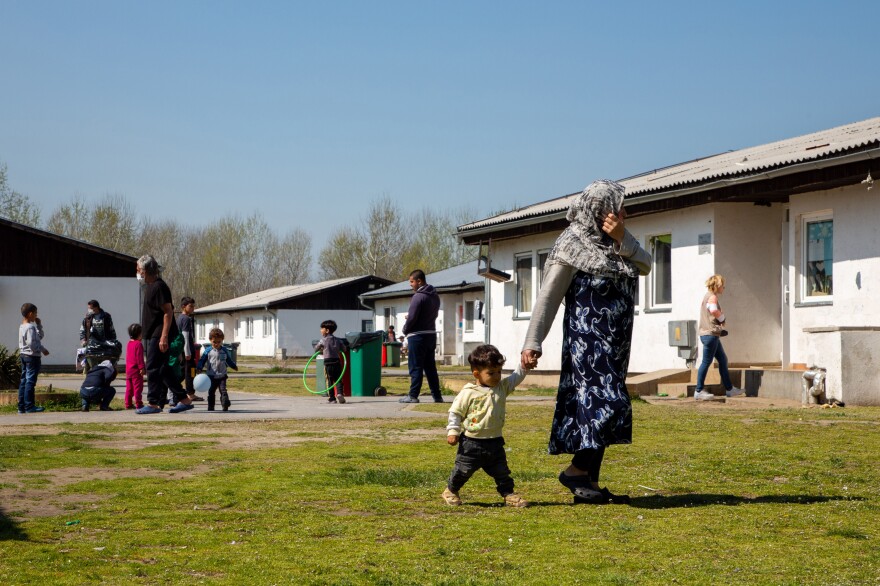BELGRADE, Serbia — Mohammad Bilal sways on a swing in the Bogovadja asylum center in central Serbia, a government-run facility that has been the Afghan teenager's temporary home. He lives here with 55 other unaccompanied children. All are migrants between the ages of 10 and 18.Bilal, 17, arrived in Serbia in March, after more than a year making his way from Afghanistan through Pakistan, Iran, Turkey, Greece and Macedonia. His family poured all their savings into sending him out of Afghanistan in search of a better life.In Iran, he says, human smugglers squeezed him into the trunk of a car with four other boys."I was sure that was my last day on earth," he told NPR in the spring. "It was boiling inside. I prayed to God to help me. Then Iranian border police beat me very hard before telling me to go to Turkey."Bilal is one of the over 1.5 million refugees and migrants who have crossed into the country since the start of the humanitarian crisis in 2015, fueled by Syria's war. In that year alone, around 550,000 registered migrants transited through Serbia, according to the U.N. Refugee Agency.Today, most are from Afghanistan, Pakistan and countries in the Mideast and North Africa. They are hoping to reach wealthier countries in the European Union, such as Austria, Germany, Italy, Spain and the Netherlands, via the central and western Balkan states. Many are unaccompanied minors and especially vulnerable to abuse.Some 5,000 refugees and migrants are currently in Serbia. Almost half are Afghans, who, like Bilal, began fleeing their country long before last month's Taliban takeover. European leaders now fear a large-scale influx of Afghan refugees amid the country's turmoil and risk of economic collapse.European Commissioner Ylva Johansson told NPR last week that Europe has a "moral duty" to help Afghan refugees now."Migration has always been here, will always be here," she said. "Of course, we have challenges, but they are manageable. And if you start panicking and being afraid of migration, then you will not be able to manage in a humane and orderly way."Wanting to avoid a return to migration levels witnessed in 2015 and 2016 — which sparked anti-migrant sentiment and the rise of far-right parties across the continent — European officials' current stand is to keep Afghan migrants outside European borders, preferring that they receive protection in the Central Asian region instead.Anti-migrant attitudes and growing resentment have found fertile ground in transit countries in the Balkans like Bosnia and Serbia, where a new, large migrant influx has further strained already limited infrastructure and battered economies, besides stoking social tension.Serbia rejected most asylum-seekers' applications last year, according to a report by the European Council on Refugees and Exiles. This year, authorities in Serbia have so far granted temporary residency on humanitarian grounds to two unaccompanied children. The country has given refugee status to three people. It's also granted six subsidiary protections — a status given to those not qualifying as refugees but in clear need of international protection.Meanwhile, the coronavirus pandemic left borders closed for months and asylum-seekers stranded."Serbia is in a difficult position," explains Milica Svabic, an activist and lawyer with KlikAktiv, a Belgrade-based nonprofit that provides legal and psychosocial support to refugees in Serbia. "On one side, it needs to respect [European Union] requests if it aims to join the bloc, meaning keeping refugees here. But, at the same time, Serbia doesn't want them here. For a reason, we don't have a functioning asylum system."Serbia borders four EU countries: Croatia, Hungary, Romania and Bulgaria. But few migrants manage to cross from it into the EU. Over the past five years, border authorities have pushed thousands of migrants back to Serbia from neighboring countries — more than 25,000 last year alone, according to the U.N. Refugee Agency. They sometimes do so with brutality, unleashing dogs and beating people with batons and broken branches, even breaking their bones, according to migrants, refugees and the humanitarian agencies serving them."They also confiscate valuables, break phones, among other extremely humiliating practices. These include stripping people naked and make them walk back barefoot in their underwear until they reach the official crossing point," says Andras Lederer, a lawyer with the Hungarian Helsinki Committee, a U.N. Refugee Agency partner.Hungarian, Romanian and Croatian authorities have denied allegations of abuse in statements sent to NPR. Few, if any, asylum-seekers choose to go from Serbia to Bulgaria as it is not on the route to wealthier countries.Hungarian Prime Minister Viktor Orban said recentlythat he was against allowing in any new migrants, saying it would "change the cultural identity of Europe.""The law and practice together make it absolutely impossible for even the most genuine asylum-seeker to seek asylum in Hungary," says Lederer. "Undocumented foreigners found inside the country don't have the right to seek asylum and are, without any procedure, immediately returned to the external side of the border fence, namely Serbia. Hungary is the only country in Europe to have legalized pushback measures."For now, human smugglers remain the main hope for asylum-seekers who land in Serbia and hope to reach elsewhere in Europe. Their journeys remain risky and dangerous, but they are unlikely to stop.Here are some images from Serbia's borderlands and asylum-seeker camps from the spring. Copyright 2021 NPR. To see more, visit https://www.npr.org.
Afghans Are Among Thousands Of Migrants Hoping To Reach Europe Via Serbia

